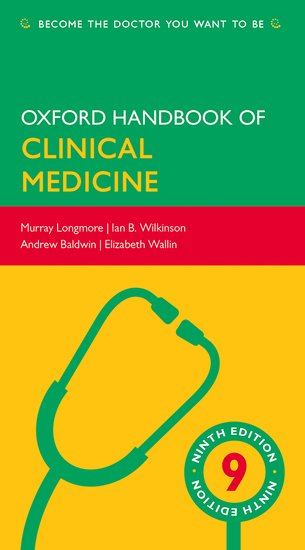By Kelly Hewinson
To mark the publication of the ninth edition of the Oxford Handbook of Clinical Medicine (OHCM), here are nine facts you may not know about the cheese and onion:
1. The OHCM is sold in over 100 countries, has been translated into 14 different languages, and has sold more than 1.5 million copies worldwide since it was first published in 1985.
2. The ninth edition is the cumulative effort of 18 authors and nearly 600 contributors, spanning a period of 30 years, ensuring the OHCM is the definitive guide to being a junior doctor.
3. To achieve the distinctive ‘topic per spread’ format, original authors Tony Hope and Murray Longmore wrote sections long-hand on squared paper — one letter per square — to make sure they would fit.
 4. The book is known as the cheese and onion because the distinct yellow and green cover design (introduced from the second edition onwards) reminded readers of cheese and onion flavoured crisps.
4. The book is known as the cheese and onion because the distinct yellow and green cover design (introduced from the second edition onwards) reminded readers of cheese and onion flavoured crisps.
5. The OHCM has always benefitted from the latest available technology: updates to the second edition (1987) were published in the British Medical Journal, purchasers of the third edition could receive updates by fax, from 2005 you could use the OHCM on your palm pilot, the app was first launched in 2008, and since 2009, institutions can subscribe to the online version.
6. The OHCM has inspired more than 50 other titles in the Oxford Medical Handbook series, with several OHCM junior author alumni going on to write their own titles, including Punit Ramrakha (OHCM3 / Oxford Handbook of Acute Medicine, Oxford Handbook of Cardiology) and Estée Török (OHCM5 / Oxford Handbook of Infectious Diseases).
7. The OHCM was banned from various UK medical schools for making medicine “too easy”, but by 2003 had made it onto several reading lists, including Royal Free London, with the comment “everybody owns this!!”
8. What do Colin Dexter, Gabriel Garcia Marquez, Dag Hammarskjöld, Johann Sebastian Bach, Dylan Thomas, Leonard Bernstein, Sherlock Holmes, Graham Green, and Oscar Wilde all have in common? They are all name checked in the pages of OHCM, giving readers a unique perspective on medicine.
9. The OHCM has inspired a poem, a song, numerous photography competitions, a fancy dress competition, as well as generations of doctors. It’s also featured in the UK BBC Three TV series Junior Doctors and the novel Bodies by Jed Mercurio (Vintage 2002).
Kelly Hewinson is Senior Marketing Manager at Oxford University Press and describes herself as the “current custodian” of the OHCM legacy.
Now in its ninth edition, the Oxford Handbook of Clinical Medicine continues to be the definitive pocket-friendly guide to medicine. The culmination over 25 years of experience at the bedside and in the community, this handbook is packed with practical advice, wit, and wisdom.
Subscribe to the OUPblog via email or RSS.
Subscribe to only science and medicine articles on the OUPblog via email or RSS.
Image credit: Salt-and-vinegar by Gerolsteiner91, Creative Commons via Wikimedia Common.


And it remains a triumph. My involvement in the Oxford Handbook of Anaesthesia was inspired by my gratitude and admiration for the third edition of OHCM. Fully annotated and packed with taped-in additions, it got me through my junior doctor years brilliantly and remains a treasured reminder of my early career.
I adore the fact that OHCM (and its sister publications) contain stimulating and inspiring quotations from literature. It reminded me then (as an exhausted junior) of two things: first, there are other sources of wisdom and encouragement beside medical textbooks, and second, that, busy though the authors must have been, they still had time to read them!